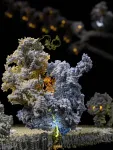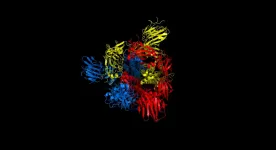(Press-News.org) University of Queensland scientists have developed an ultraviolet 'television' display designed to help researchers better understand how animals see the world.
Until now, standard monitors on devices like televisions or computer screens have been used to display visual stimuli in animal vision studies, but none have been able to test ultraviolet vision - the ability to see wavelengths of light shorter than 400 nanometres.
Dr Samuel Powell, from the Queensland Brain Institute's Marshall lab, said this new technology will help unveil the secrets of sight in all sorts of animals, such as fish, birds and insects.
"Human TVs generally use three colours - red, green and blue - to create images, but our newly-developed displays have five, including violet and ultraviolet," Dr Powell said.
"Using this display, it's now possible to show animals simple shapes, to test their ability to tell colours apart, or their perception of motion by moving dot patterns.
"We affectionately call it the 'UV-TV', but I doubt that anyone would want one in their home!
"You'd have to wear sunglasses and sunscreen while watching it, and the resolution is quite low - 8 by 12 pixels in a 4 by 5 centimetre area - so don't expect to be watching Netflix in ultraviolet anytime soon.
"This very low resolution is enough to show dot patterns to test fish perception, in what's known as an Ishihara test, which would be familiar to anyone who's been tested for colour blindness.
"In this test, humans read a number hidden in a bunch of coloured dots, but as animals can't read numbers back to us, they're trained to peck the 'odd dot' out of a field of differently coloured dots."
Dr Karen Cheney from UQ's School of Biological Sciences said this technology will allow researchers to expand our understanding of animal biology.
"There are many colour patterns in nature that are invisible to us because we cannot detect UV," Dr Cheney said.
"Bees use UV patterns on flowers to locate nectar, for example, and fish can recognise individuals using UV facial patterns.
"We've recently started studying the vision of anemonefish or clownfish - aka, Nemo - which, unlike humans, have UV-sensitive vision.
"Our research is already showing that the white stripes on anemonefish also reflect UV, so we think UV colour signals may be used to recognise each other and may be involved in signalling dominance within their social group.
"Who knows what other discoveries we can now make about how certain animals behave, interact and think.
"This technology is allowing us to understand how animals see the world, helping answer significant questions about animal behaviour."
INFORMATION:
The research has been published in Methods in Ecology and Evolution (DOI: 10.1111/2041-210X.13555).
Mitochondria are organelles that act as the powerhouses in our body. They use oxygen which we inhale and food we eat to produce energy that supports our life. This molecular activity is performed by bioenergetic nano-factories incorporated in specialized mitochondrial membranes. The nano-factories consist of proteins cooperatively transporting ions and electrons to generate chemical energy. Those have to be constantly maintained, replaced and duplicated during cell division. To address this, mitochondria have their own bioenergy protein-making machine called the mitoribosome. Given its key role, a deregulation of the mitoribosome can lead to medical disorders such as deafness and diseases including cancer development. The first fundamental understanding of how mitoribosomes ...
A POSTECH-KAIST joint research team has successfully developed a technique to reach near-unity efficiency of SHEL by using an artificially-designed metasurface.
Professor Junsuk Rho of POSTECH's departments of mechanical engineering and chemical engineering, and Ph.D. candidate Minkyung Kim and Dr. Dasol Lee of Department of Mechanical Engineering in collaboration with Professor Bumki Min and Hyukjoon Cho of the Department of Mechanical Engineering at KAIST have together proposed a technique to enhance the SHEL with near 100% efficiency using an anisotropic metasurface. For this, the joint research team designed a metasurface that transmits most ...
Photo and map
Robotic laboratories on the bottom of Lake Erie have revealed that the muddy sediments there release nearly as much of the nutrient phosphorus into the surrounding waters as enters the lake's central basin each year from rivers and their tributaries.
Excessive phosphorus, largely from agricultural sources, contributes to the annual summer cyanobacteria bloom that plagues Lake Erie's western basin and the central basin's annual "dead zone," an oxygen-starved region that blankets several thousand square miles of lake bottom and that reduces habitat for fish and other organisms.
The release of phosphorus from Lake Erie sediments during periods of low oxygen--a phenomenon known as self-fertilization or internal loading--has been acknowledged since the 1970s. ...
We are most familiar with the four conventional phases of matter: solid, liquid, gas, and plasma. Changes between two phases, known as phase transitions, are marked by abrupt changes in material properties such as density. In recent decades a wide body of physics research has been devoted to discovering new unconventional phases of matter, which typically emerge at ultra-low temperatures or in specially-structured materials. Exotic "topological" phases exhibit properties that can only change in a quantized (step-wise) manner, making them intrinsically robust against impurities and defects.
In addition to topological ...
Despite our great progress in understanding various cellular mechanisms over the last decades, many of them remain unclear. Such is the case for exosomes, small vesicles released by cells that contain genetic materials called "RNA" and various proteins. The roles of exosomes are believed to be very varied and important, both for normal bodily functions and also in the spreading of diseases like cancer. However, exosomes are so small that studying them is challenging and calls for costly and time-consuming techniques, such as electron microscopy (EM).
To tackle this issue, a team of undergraduate students from ...
Scientists have achieved a breakthrough in predicting the behaviour of neurons in large networks operating at the mysterious edge of chaos.
New research from the University of Sussex and Kyoto University outlines a new method capable of analysing the masses of data generated by thousands of individual neurons.
The new framework outperforms previous models in predicting and assessing network properties by more accurately estimating a system's fluctuations with greater sensitivity to parameter changes.
As new technologies allow recording of thousands of neurons from living animals, there is a pressing demand for mathematical tools to study the non-equilibrium, complex dynamics of the high-dimensional ...
Cancer researcher Rita Fior uses zebrafish to study human cancer. Though this may seem like an unlikely match, her work shows great promise with forthcoming applications in personalised medicine.
The basic principle of Fior's approach relies on transplanting human cancer cells into dozens of zebrafish larvae. The fish then serve as "living test tubes" where various treatments, such as different chemotherapy drugs, can be tested to reveal which works best. The assay is rapid, producing an answer within four short days.
Some years ago, when Fior was developing this assay, she noticed something curious. "The majority of human ...
University of Warwick scientists model movements of nearly 300 protein structures in Covid-19
Scientists can use the simulations to identify potential targets to test with existing drugs, and even check effectiveness with future Covid variants
Simulation of virus spike protein, part of the virus's 'corona', shows promising mechanism that could potentially be blocked
Researchers have publicly released data on all protein structures to aid efforts to find potential drug targets: https://warwick.ac.uk/flex-covid19-data
Researchers have detailed a mechanism in the ...
Genetic mutations which occur naturally during the earliest stages of an embryo's development can cause the severe birth defect spina bifida, finds a new experimental study in mice led by UCL scientists.
The research, published in Nature Communications, explains for the first time how a 'mosaic mutation' - a mutation which is not inherited from either parent (either via sperm or egg cell) but occurs randomly during cell divisions in the developing embryo - causes spina bifida.
Specifically the scientists, based at UCL Great Ormond Street Institute of Child Health, found that when a mutation in the gene Vangl2 (which contains information needed to create spinal cord tissue) was present in 16% of developing spinal cord cells of mouse embryos, this ...
The Biden administration is revising the social cost of carbon (SCC), a decade-old cost-benefit metric used to inform climate policy by placing a monetary value on the impact of climate change. In a newly published analysis in the journal Nature, a team of researchers lists a series of measures the administration should consider in recalculating the SCC.
"President Biden signed a Day One executive order to create an interim SCC within a month and setting up a process to produce a final, updated SCC within a year," explains Gernot Wagner, a climate economist at New York University's Department of Environmental Studies and NYU's Robert F. Wagner Graduate School of Public Service and the paper's lead author. "Our work outlines how the ...




